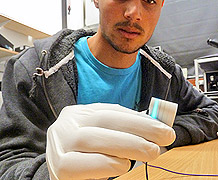
GraphExeter is a material adapted from the ‘wonder material’ graphene.
Exeter researchers have substantially improved the effectiveness of large, flat, flexible lighting via GraphExeter – a material adapted from the ‘wonder material’ graphene. By using GraphExeter, the most transparent, lightweight and flexible material for conducting electricity, instead of pure graphene, the team have increased the brightness of flexible lights by up to almost 50%. The research has also shown GraphExeter makes the lights 30% more efficient than existing examples of flexible lighting, based on state-of-the-art commercial polymers.
The research team believe the breakthrough could help significantly improve the viability of the next generation of flexible screens, which could be used for display screens...
Read More








Recent Comments